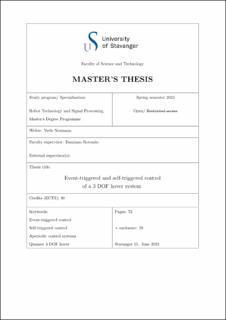| dc.description.abstract | Many modern control systems are implemented on devices that are resource constrained
in the form of computational power, energy consumption or bandwidth. Control systems
are conventionally implemented through periodic sampling and updating of the control
action, referred to as periodic control systems. As a consequence, periodic control systems
waste resources by updating the control action and sampling the state of a system, even
when it is not necessary. A more efficient way of spending resources is only to update
the control action or conduct sampling when necessary, referred to as aperiodic control
systems.
This thesis presents the theoretical background, implementation in simulation and
experimental validation of two strategies for realising aperiodic control systems. The
two strategies are event-triggered and self-triggered control. The Quanser 3 DOF hover,
an experimental drone-like system, serves as the basis for both the simulation model
and experimental validation of the two strategies. Event-triggered control is a reactive
strategy, meaning it continuously monitors the state of the system to update the control
action aperiodically. Whereas self-triggered control is a proactive strategy, meaning that
the state of the system is sampled aperiodically, as well as the update of the control action.
Both strategies are designed based on the solution of a linear matrix inequality derived
from a Lyapunov function. It is found that both strategies perform well in simulation, but
only the event-triggered control strategy provides adequate performance on the Quanser
3 DOF hover. The reason why the self-triggered control strategy performs inadequately
when tested on the Quanser 3 DOF hover is likely due to unmodelled dynamics and
disturbances. | |
